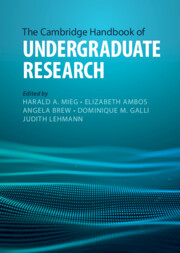Book contents
- The Cambridge Handbook of Undergraduate Research
- The Cambridge Handbook of Undergraduate Research
- Copyright page
- Contents
- Figures
- Tables
- Contributors
- Foreword
- Foreword
- 1 Introduction
- Part I Theory and Research on Undergraduate Research
- Part II Implementation, Approaches, Methods
- Part III Disciplines
- Part IV International Perspective
- Part V Avenues for Developing Undergraduate Research
- 73 Synopsis and Introduction
- 74 Community-Based Undergraduate Research
- 75 Interdisciplinary Undergraduate Research
- 76 Undergraduate Research in Digital Learning Environments
- 77 Crosscultural Undergraduate Research
- Index
- References
76 - Undergraduate Research in Digital Learning Environments
from Part V - Avenues for Developing Undergraduate Research
Published online by Cambridge University Press: 11 August 2022
- The Cambridge Handbook of Undergraduate Research
- The Cambridge Handbook of Undergraduate Research
- Copyright page
- Contents
- Figures
- Tables
- Contributors
- Foreword
- Foreword
- 1 Introduction
- Part I Theory and Research on Undergraduate Research
- Part II Implementation, Approaches, Methods
- Part III Disciplines
- Part IV International Perspective
- Part V Avenues for Developing Undergraduate Research
- 73 Synopsis and Introduction
- 74 Community-Based Undergraduate Research
- 75 Interdisciplinary Undergraduate Research
- 76 Undergraduate Research in Digital Learning Environments
- 77 Crosscultural Undergraduate Research
- Index
- References
Summary
Digitalization is strongly affecting the field of higher education. This chapter investigates the implications of digital tools for the future development of undergraduate research (UR). It asks how the design of digital learning environments and the provision of digital tools can contribute to UR. The chapter starts with outlining digitalization in higher education and the use of digital technology in undergraduate studies. Then, teaching and learning scenarios are presented that serve as design options to integrate digital learning environments in teaching for UR. Moreover, digital tools are analyzed that can support different phases and objectives of UR. Overall, the chapter stresses the importance to critically consider the added value of digital technology for learning in general and for the case of teaching and learning UR in particular. A well-elaborated instructional design plays a key role to develop and implement digital learning environments in UR, to spur student engagement and to foster social interaction successfully. The chapter concludes by discussing future trajectories for UR in the light of digitalization.
Keywords
- Type
- Chapter
- Information
- The Cambridge Handbook of Undergraduate Research , pp. 695 - 708Publisher: Cambridge University PressPrint publication year: 2022
References
- 2
- Cited by



